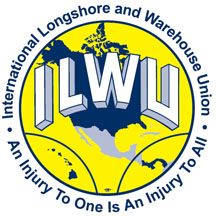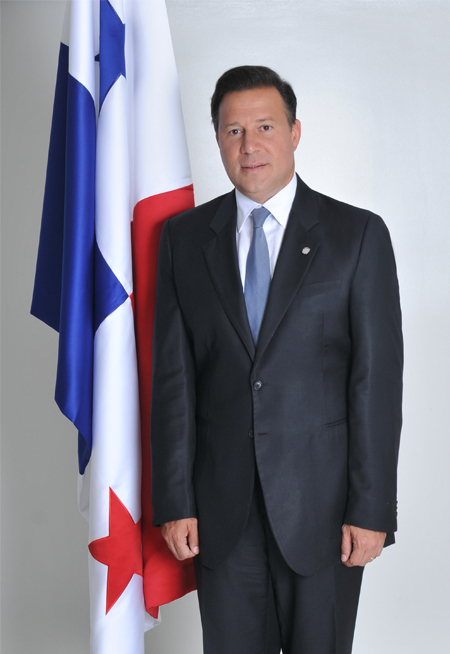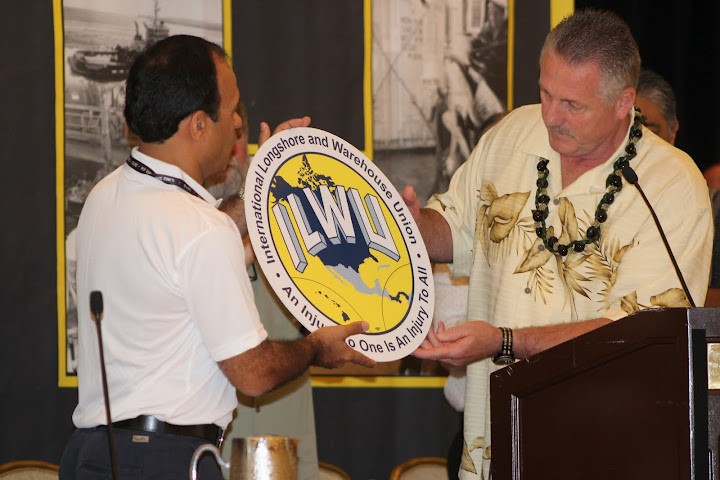
”ILWU supports SITREBALCRI in your fight for good-paying jobs and a fair contract for all workers in the union.” ILWU International President Bob McEllrath led a solidarity delegation to Panama in September 2011, part of an ongoing effort to support maritime workers there. Dockworkers in this photo have since changed their union’s name to SINTRAPORSPA, affiliated with the ILWU Panama Canal Division and won a four-year contract in December that will improve pay and working conditions at Panama Ports – a subsidiary of the powerful Hong Kong-based Hutchinson Port Holdings.
From labor author David Bacon, in the Dispatcher:
Panama City, Panama – You see a lot of parked taxis in the parking lot at the Panama Ports terminal here. They’re not waiting to give rides to longshoremen. Dockworkers themselves are the drivers.
Longshore wages in Panama are so low that after a shift driving a crane, a longshoreman has to put in another shift driving a taxi, just to survive.
At Panama Ports, however, this situation has begun to change. In December the union signed an historic new contract with raises totaling more than 27% over the next four years.
One factor that made this agreement possible was support from the ILWU International Union. Because of it the Panamanian union SINTRAPORSPA, the Union of Workers at Panama Ports has decided to become the newest member of the ILWU’s Panama Canal Division. “Because we affiliated with the ILWU, things have changed,” says Alberto Ochoa, SINTRAPORSPA’s Secretary General. “Now our relationship with the company is more equal. We have greater strength at work, and our contract shows it.”
The Panama Canal Pilots, ILWU International President Bob McEllrath and Vice-President Ray Familathe began coordinating the latest affiliation agreement with Panama’s longshore workers belonging to SINTRAPORSPA.
ILWU President Bob McEllrath collaborated closely with Familathe to implement their vision of growing the Panama Division. McEllrath and Familathe traveled to Panama with fluent Spanish-speaker Greg Mitre, President of the Southern California Pensioners’ Group, to build union-to-union relationships.
“Our union is committed to defending the rights of all workers, and the Panama Division is the result of that commitment,” McEllrath says.
When the Panama Division was established in 2012, ILWU President Bob McEllrath explained, “With so many employers now going global, it’s critical for workers around the globe to join forces and work together.”
The division has now grown much larger, to include 2580 Panama Ports longshore workers. The symbol of the ILWU has also been updated. It used to be a map of North America with a picture of Hawaii, showing the union’s strength in U.S. and Canadian ports and in the islands. The symbol now includes a new element – a map of Panama.According to Capt. Rainiero Salas, the Panama Canal Pilots’ Union secretary general, “The Panama Division is growing as workers see what we can gain by working together, and it’s not going to stop here.”
The new Panama Ports longshore contract didn’t come easily. Panama Ports is a subsidiary of the Hong Kong-based corporation Hutchinson Port Holdings Limited (HPH).
There was a “yellow” or company union at the terminal there for many years. Ochoa and other independent minded workers had a long history of trying to change it. Finally they organized SINTRAPORSPA. They collected over 2000 signatures on a petition for recognition, and asked for a government-administered election to certify the union as workers’ bargaining representative.
Dockworkers knew how many votes they had lined up, and challenged the transparency of the election. The Ministry of Labor claimed that 1500 workers had cast ballots against SINTRAPORSPA. The President of Panama himself, Juan Carlos Varela, is a partner in the law firm used by Panama Ports, that specializes in helping company management fight unions.
“When we went to the ministry to protest the crooked election, they did everything they could to stop us,” recalls Ramiro Cortez, another SINTRAPORSPA leader. “Nevertheless, it was obvious that we had the support of the great majority of the workers, including those who belonged to the company union.”ANTI-UNION: Juan Carlos Varela, President of Panama, is a partner in the law firm used by Panama Ports, that specializes in helping company management fight unions.
Ochoa and Cortez made an appeal to the ILWU, and Familathe and Mitre flew to Panama City and met with the Minister of Labor, Luis Ernesto Carles Rudy. They brought with them a letter signed by six U.S. Congress members, asking for a transparent process.
The government agreed to rerun the election, and in a fair vote SINTRAPORSPA won overwhelmingly. “The support from the ILWU was very effective in meeting with the Minister of Labor, and getting the second union election,” Cortez says. “The Panamanian authorities were never concerned about how they conducted themselves with us before that. Powerful companies, with the money at their disposal, got whatever that money could buy.”
The impact of that support was also felt in the subsequent contract negotiations, which only took a month to reach an agreement. In one meeting the company executive president even told union negotiators that he was “very concerned” at the union’s growing relationship with the ILWU. The contract itself is now the first agreement between an ILWU affiliate and Panama Ports a subsidiary of Hutchinson Port Holdings.
Danger & low pay
That agreement will have a big impact on the lives of longshoremen and their families in two areas especially – economics and safety. In Panama they call longshore pay “hunger wages.” Workers’ families live below the government’s own poverty line, and some families literally go hungry.
“That’s one reason why the company had to constantly hire new workers,” Cortez says. “Most people who got jobs here were just working while they were actually looking for better jobs somewhere else.” An agreement that raises wages therefore helps to stabilize the workforce, which can make the terminal more productive.
It also impacts safety. “Many accidents in the port could have been avoided if the workers weren’t so exhausted,” he explains. “They go in at 7AM, and leave at 8PM, and then go and drive or do some other job.”
The port does have a high accident rate, and two workers were killed a month apart at the end of last year. But the contract is also changing how safety issues are handled. In one accident, a crane lifting a container hit a six-high stack of boxes that were being stored on the dock, right next to the ship. As they fell, one hit a 22-year-old man who’d been working less than a month.
Cortez was called by the workers, and on arrival met with the crane operator who was in shock and crying, and stopped managers from interrogating him until he got representation and counseling. Then Cortez and other union leaders met with management and viewed the video of the accident. They told the company that all workers were traumatized by what happened, and should be sent home. If not, the union itself would shut down the terminal, they said. In the end, management sent the shift home with pay for the day.
When Cortez announced the agreement to the workers, they applauded. “I could have been elected president of the republic that day,” he says. “It had never happened before.”
When Familathe and Mitre explained how similar events are handled in Los Angeles, Cortez said he wanted to come and see for himself. The new union contract establishes five committees, the most important of which is safety. The union then created three new positions, and appointed a high-voltage technician to serve as secretary of the safety committee.According to Capt. Rainiero Salas, the Panama Canal Pilots’ Union secretary general pictured above with Pres. McEllrath: ”The Panama Division is growing as workers see what we can gain by working together, and it’s not going to stop here.” Photo by Lewis Wright, ILWU Pensioner
“The challenge is now to implement the contract and ensure that the company abides by it, so that the workers actually benefit from it,” President Ochoa emphasizes. “Before the company did what it pleased, and changed the hours, overtime, days off, and wages, whenever it wanted. Now they know we’re not on our own, by ourselves.
They didn’t look on our relationship with the ILWU with friendly eyes, because they knew you would back us up. Companies don’t want real unions because we open the eyes of the workers, and we can win respect.”
Opportunities to grow
Ochoa has another vision as well – that the Panama Division will expand. “Unions in the ports and the Canal should get together so that we can speak with one voice, and get better benefits and respect for the workers,” he says. “I’m very grateful for the opportunity to realize this dream.”
It may not be so far off. The same day Familathe and Mitre concluded the affiliation process for SINTRAPORSPA they also drove across the isthmus to meet with the union for dockers in Colon on the Atlantic, the Union of Workers at the Manzanillo International Terminal. The MIT terminal is operated by SSA Marine.
Workers told the ILWU leaders that crane operators work 8-hour days, for six days straight. For that, their pay starts at $854 a month. Here also the workers rebelled against a former union leadership they viewed as too close to the company, and elected a new slate a few months ago. “They see the improvements SINTRAPORSPA was able to make, and they want the same thing,” said Familathe.



